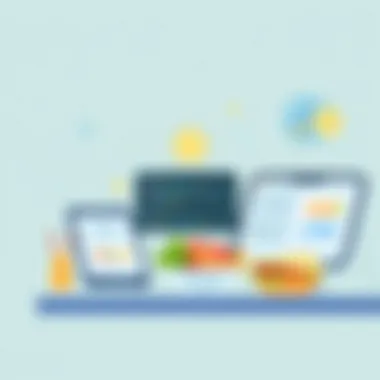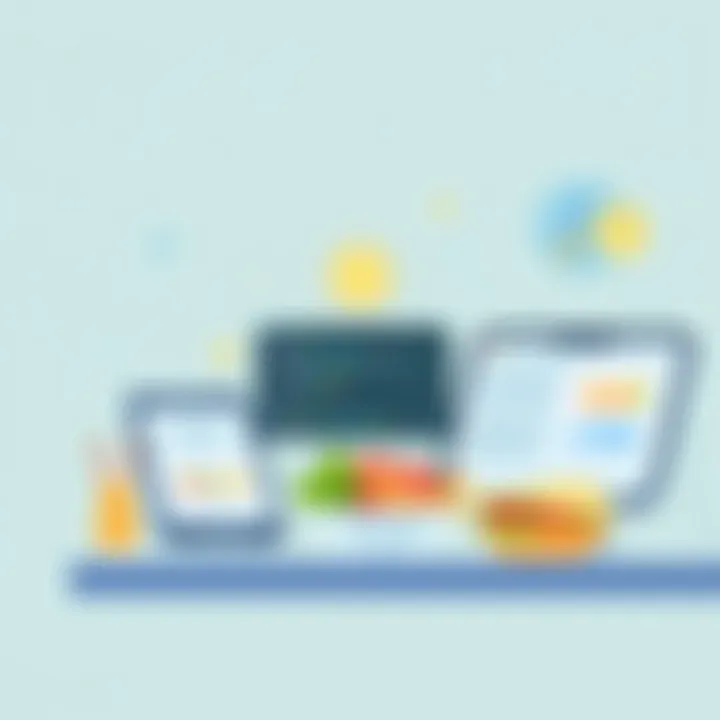Mobile Meals App: An In-Depth Exploration of Trends


Intro
The digital age has ushered in a range of applications that span across myriad industries, and one area where this growth is particularly evident is in the realm of food procurement. Mobile meal apps are no longer merely a discussion topic; they’ve become a fundamental part of how many consumers approach food choices and dining experiences. This article will delve into the landscape of mobile meal applications, casting light on their functionalities, the methods used to engage users, and the overarching impact they have on the food industry and consumer behavior.
We’re diving into some key aspects of these applications that reflect not just consumer preferences but also the technological advancements that make these platforms viable. With an increasing number of consumers turning to their smartphones for meals, understanding the mechanics and strategies employed by these apps is more important than ever.
Software Category Overview
Purpose and Importance
Mobile meal applications serve a dual purpose: they simplify meal procurement and offer users a wealth of food choices at their fingertips. By fostering connections between consumers and a diverse array of food providers, these apps play a crucial role in modern eating habits. Convenience is at the heart of their allure, allowing busy individuals to place an order with just a few clicks, eliminating the need to visit restaurants or grocery stores in person. Furthermore, the convenience provided by these apps has led to an uptick in the use of delivery services, impacting the way local businesses operate.
There’s no denying that mobile meal apps have also transformed consumer expectations. Quick service and variety have become paramount. For instance, users now anticipate a broad selection ranging from organic meal kits to gourmet takeout from their favorite local bistros. Their importance isn't merely tied to convenience; they also provide exposure to cuisines that individuals might not consider otherwise, thus expanding palates and dining experiences across the board.
Current Trends in the Software Category
Recent trends in the mobile meal app market reveal an astonishing shift towards personalization. With the advent of artificial intelligence and machine learning, these platforms can offer tailored recommendations based on past purchases and user preferences. For instance, an app might suggest a spicy sushi roll to someone who frequently orders Japanese cuisine while nudging another user toward vegan options if that's more in line with their profile.
Another notable trend is the rise of contactless delivery options, which became particularly pronounced during the pandemic and persist as a preferred method for many consumers today. App features that allow for no-contact deliveries—where meals are simply dropped off at the customer’s door—underscore a growing emphasis on safety and convenience.
Integration with social media channels and peer reviews is increasingly common as well. Consumers lean on their networks for recommendations, and apps that harness these elements often find greater success. By embedding features that allow users to share their favorite eats or their latest discoveries on platforms like Facebook or Instagram, these apps capitalize on the collective wisdom of the crowd.
Data-Driven Analysis
Metrics and Criteria for Evaluation
When assessing the landscape of mobile meal applications, several key metrics are pivotal:
- User Engagement: Measuring how often users return to the app, what offers attract attention, and which functionalities boost regular use.
- Customer Retention Rates: Understanding how well these apps keep users engaged long-term is crucial. High retention rates are often indicative of a successful user experience.
- Order Frequency and Size: The amount spent per order and how often users make a purchase dictate the financial viability of the app.
- Market Coverage: The geographical reach and the variety of establishments covered can also signal the comprehensiveness of the app.
Comparative Data on Leading Software Solutions
Analyzing leading mobile meal applications paints a vivid picture of the competitive landscape:
- Uber Eats has emerged as a frontrunner due to its vast network of restaurants, innovative marketing, and user-friendly interface. Uber's integration with ride-sharing services allows for seamless logistics, which adds to customer satisfaction.
- DoorDash, known for its unique market features such as DashPass, which offers subscription-based delivery discounts, has captured significant market share by ensuring food delivery is not just reliable but economical for frequent users.
- Grubhub, meanwhile, differentiates itself with a strong focus on supporting local restaurants, a sentiment that resonates with consumers increasingly concerned about supporting their communities.
This analysis underlines the fierce competition and dynamism within the mobile meal app space and how these platforms must continuously adapt to retain user loyalty and meet evolving consumer demands.
In an age where convenience is king, mobile meal apps have redefined not just how meals are ordered, but also how cultural influences and dietary trends are shared and celebrated globally.
Prelude to Mobile Meals Apps
The landscape of food procurement has experienced a seismic shift with the introduction and rapid adoption of mobile meals applications. These digital tools address the increasing demand for convenience, variety, and customization, aligning perfectly with the fast-paced lifestyle many individuals lead today. Understanding mobile meals apps is crucial not just for consumers but also for businesses in the culinary sector, as they adapt to the evolving dynamics of how people choose to eat.
Definition and Purpose
Mobile meals apps serve as platforms that facilitate the ordering and delivery of food directly to consumers. At their core, these applications aim to simplify the meal acquisition process, providing users with an array of options ranging from fast food to gourmet cooked meals right at their fingertips. Typically, they are designed with a user-centric approach, allowing for various functionalities such as filtering meals based on dietary preferences, viewing restaurant menus, and tracking order statuses in real-time. Their purpose isn’t merely to deliver food; it is to enhance the overall dining experience by making it more accessible and tailored to the users' needs.
Historical Overview
The journey of mobile meals applications is intertwined with the rise of mobile technology and the internet. Although food delivery services have existed for decades, it was not until the ubiquity of smartphones and the advancement of app development frameworks that the concept gained significant traction. The first applications, such as Grubhub and Seamless, emerged in the late 2000s, leveraging online ordering systems to connect consumers with local restaurants.
As technology evolved, so did consumer expectations. By the early 2010s, the proliferation of GPS functionality on smartphones made it easier for delivery services to optimize routing and timeliness, further enhancing user satisfaction. What set the stage for a more profound transformation was the integration of AI and data analytics by companies like Uber Eats. This allowed not only for more streamlined logistics but also enabled personalized marketing strategies that cater to individual consumer tastes.
Looking back, the development of mobile meals apps symbolizes a broader societal change; they are not merely a convenience but a reflection of changing consumer patterns. They cater to increasingly busy lifestyles while also tapping into the latest tech trends to create an enriched user experience. For further reading on the evolution of mobile apps, check out articles from Britannica or explore discussions on Reddit.
"Mobile meals apps are redefining how we approach dining, merging technology with culinary creativity."
In summary, mobile meals applications have become essential tools in modern consumer culture, not only facilitating food acquisition but also shaping the way we think about meal experiences. As we explore the various features, market players, and future trends, we will further understand the implications of this increasingly vital area of technology.
Key Features of Mobile Meals Apps
Mobile meals apps have become a staple in modern dining, reshaping how consumers interact with food. Understanding the key features of these apps is critical for grasping their significance in today's fast-paced world. These features not only enhance user experience but also drive engagement and loyalty in a very competitive market. The integration of technology with culinary preferences presents a unique way to cater to diverse audiences, making it more necessary than ever to dissect what makes these applications noteworthy.


User-Friendly Interface
A user-friendly interface is essential in any tech product, but it holds special weight in mobile meals applications. Most users expect simple navigation, clean layouts, and logical workflows when they are ordering food on-the-go. The ease of access to your favorites or new dishes can directly affect customer satisfaction. Suppose you try to order a meal through a convoluted and cluttered interface. It can be downright frustrating, leading many to abandon their purchase. Key characteristics include large buttons, clear typography, and intuitive category sorting. A smooth experience leads to repeat usage, which is the gold standard for app developers.
Order Customization
Order customization is the lifeblood for mobile meals apps, allowing users to personalize their dining experience according to their tastes and dietary restrictions.
Dietary Preferences
When it comes to dietary preferences, these apps provide flexibility for health-conscious consumers or those with special dietary needs. Users can filter options based on vegan, gluten-free, or low-carb choices, among others. This aspect is increasingly popular, as more individuals prioritize health and wellness over convenience. A unique feature here is the ability to save dietary preferences in user profiles, making re-ordering a breeze. However, one potential downside might be the limitation in local restaurant partnerships that could restrict options in some areas.
Ingredient Substitutions
Ingredient substitutions capitalize on the trend of personalized dining experiences. Users often face the dilemma of liking a dish but being allergic or sensitive to a specific component within it. Through mobile meals apps, users can easily request ingredient changes, such as swapping out dairy or nuts, offering a sense of control over what they eat. This feature is beneficial, as it caters to niche dietary requirements while also enhancing the likelihood of customer retention. On the flip side, not all restaurants can accommodate such requests, which can lead to user disappointment if their preferences cannot be met efficiently.
Payment Options
A seamless payment process is crucial to keeping the user experience smooth and efficient. With mobile meals apps, various payment options become a significant determining factor in user satisfaction.
Credit/Debit Cards
Using credit and debit cards remains one of the most common methods for transactions in apps. This payment method offers trust and security, backed by well-established financial institutions. Many apps provide the option to save card details for future orders, eliminating the hassle of entering information each time. However, users should be cautious about potential security vulnerabilities that can arise from saved payment information. It remains vital for apps to ensure high-grade encryption to mitigate such risks.
Digital Wallets
Digital wallets like PayPal, Apple Pay, and Google Wallet have surged in popularity, mainly due to their convenience and speed. These methods enable users to pay for meals without even taking their credit cards out. It’s much more efficient for quick transactions, especially for busy consumers. However, the range of accepted digital wallets can vary significantly between apps, affecting user willingness to adopt this payment option. Still, the growing trend towards digital wallets aligns well with the increasing reliance on technology in daily life.
In summary, the key features of mobile meals apps are not just about order placement but rather complex systems that cater to user needs, preferences, and security. They significantly impact consumer behavior and engagement in the digital dining space.
Ultimately, these features contribute to a well-rounded and user-centric application, elevating the whole experience of ordering meals through a mobile platform.
Popular Mobile Meals Apps in the Market
The landscape of mobile meal applications is vividly marked by a variety of services that cater to different needs and preferences. Understanding the popular meal apps in the market is crucial because they shape consumer behavior and the way food is delivered and prepared. These apps not only simplify the process of ordering food but also enable access to a wider range of culinary experiences. Their significance extends beyond mere convenience, as they connect consumers with local restaurants and meal kits, fostering a tapestry of culinary culture and community engagement.
Delivery Platforms
DoorDash
DoorDash stands out in the crowded delivery platform arena, primarily because of its broad reach and extensive network of restaurants. One of its key characteristics is the simple and intuitive interface, which allows users to browse and order food from their favorite restaurants quickly. Additionally, DoorDash often has exclusive partnerships with various local eateries that often don’t feature on other platforms, providing unique offerings that encourage users to explore beyond mainstream dining choices.
A unique feature of DoorDash is its DashPass program, which offers subscribers free delivery on eligible orders from participating restaurants for a monthly fee. This not only incentivizes frequent orders but also drives customer loyalty. However, it's important to note that while this subscription model can save money for frequent users, others may find the delivery fees sometimes can add up, especially during peak hours.
Uber Eats
Uber Eats has carved a niche for itself by not just being a delivery service but also by enhancing the overall dining experience. Its strategic integration with the Uber rideshare app is a significant aspect, allowing users to easily switch from finding a ride to ordering dinner. What sets Uber Eats apart is its commitment to real-time tracking, letting customers keep tabs on their orders with minimal anxiety.
Moreover, Uber Eats leverages algorithms for personalized recommendations, making it a beneficial choice for users who appreciate tailored suggestions based on their past orders. A unique aspect of Uber Eats is its ability to offer pickup options, allowing diners to order in advance and skip delivery fees altogether. On the downside, some users have reported variability in delivery times and service quality, particularly during busy times, which can lead to frustration.
Meal Kit Services
Blue Apron
Blue Apron has made a name for itself in the meal kit arena, catering to those who prefer cooking at home without the hassle of grocery shopping. A standout characteristic of Blue Apron is its commitment to fresh, high-quality ingredients. The recipes are designed to be straightforward, aiming to reduce preparation time while maintaining an exciting culinary experience.
Additionally, Blue Apron’s focus on sustainability sets it apart from competitors, as they often source produce and seafood from responsible suppliers. A unique feature of Blue Apron is its wine pairing option, allowing customers to receive curated wines compatible with their meal choices. However, it’s worth mentioning that some users might find the subscription a bit rigid, especially those who prefer more flexibility in their dining choices.
HelloFresh
HelloFresh is another prominent player in the meal kit service sector and stands out due to its wide variety of meal plans that cater to different dietary needs, from vegetarian options to family-friendly meals. Its key characteristic is the ability to offer meals that can be prepared in 30 minutes or less, appealing to busy individuals and families.
The fun culinary experience that HelloFresh provides is marked by colorful and detailed recipe cards, which help even novice cooks feel confident. A unique feature of HelloFresh is the flexibility to easily skip weeks or adjust meal selections, offering a level of convenience that many users appreciate. Yet, some feedback suggests that the portion sizes may not fully satisfy voracious eaters, leading to concerns about the value for money.


By exploring these popular meal apps, consumers not only gain access to diverse food options but also contribute to a booming economy that thrives on convenience and personalization.
Technological Considerations
In the modern digital age, the role of technology in shaping consumer experiences is more pronounced than ever. When it comes to mobile meals apps, understanding the nuances of technological considerations is crucial. These apps don't merely serve as interactive menus on our phones; they are platforms that amalgamate logistics, user preferences, and data security in one digital interface.
Effective technological considerations impact the usability, efficiency, and overall satisfaction derived from these applications, directly influencing user retention and engagement. It's not just about having an app; it’s about creating a seamless experience that integrates well with various devices and supports users' needs. Therefore, diving into specific elements like mobile compatibility and data security becomes paramount for anyone keen on understanding what makes a mobile meals app successful.
Mobile Compatibility
Mobile compatibility is one of the backbone elements of mobile meals apps. Simply put, this means the app needs to run effectively on both major operating systems: iOS and Android. Each platform comes with its own set of technical standards, user expectations, and technical specifications, which can affect how apps perform and deliver experiences to users.
iOS vs Android Performance
The performance of apps on iOS vs Android can be quite different due to the distinct ecosystems. Usually, iOS apps demonstrate more consistent performance in terms of speed and reliability, owing to strict guidelines and controlled hardware configurations. This can lead to a smoother user experience since developers can optimize apps specifically for Apple's devices.
For instance, when a user orders a meal through an app like Uber Eats on an iPhone, they might find that the app responds quickly without glitches. This experience adds to user satisfaction, making iOS a preferable choice for many. However, the drawback lies in the limited customization options compared to Android, which gives users a broader variety in terms of device selection but may result in varied performance levels across different manufacturers.
Responsive Design
In conjunction with compatibility, the concept of responsive design cannot be overlooked. A well-designed app should be able to adjust its interface depending on the device screen size. This adaptability ensures that users get an optimized experience regardless of whether they are on a smartphone or a tablet.
The unique feature of responsive design involves fluid grids and flexible images, allowing elements like menus and images to scale down without losing quality or becoming unwieldy. In mobile meals apps, this approach ensures that users can comfortably navigate through various food options, which is fundamental when users are making quick decisions about their meals, especially on the go.
However, mastering responsive design can be a double-edged sword. While it enhances usability and improves user satisfaction, achieving this degree of flexibility can complicate the development process and lead to increased costs. Thus, businesses must balance design elegance with practical implementation.
Data Security and Privacy
In an age where data breaches are rampant, mobile meals apps must prioritize data security and privacy. Users share considerable personal information when using these apps, from payment details to location data. Therefore, robust security measures are not just recommended but essential.
Apps should implement encryption protocols, such as SSL, to protect sensitive information during data transmission. On top of technical safeguards, informing users about how their data will be used and making privacy policies transparent can build trust. This is vital, as a single security incident can not only erode user trust but also significantly impact a company's reputation.
"In the digital landscape, securing consumer data is non-negotiable; it is foundational to a fruitful relationship between businesses and users."
User Engagement and Retention Strategies
User engagement and retention are paramount in the competitive arena of mobile meals apps. As users navigate daily with a multitude of options at their fingertips, fostering loyalty becomes an intricate dance. Apps that manage to both engage the user experience and ensure ongoing interaction are more likely to thrive and succeed in this thirsty market.
Engagement strategies are crucial for not just attracting users but also for keeping them interested over time. The more engaged a user feels with the app, the more likely they are to make repeat purchases. This can stem from the app being easy to navigate, exciting offers, or even just a friendly and intuitive user experience.
Loyalty Programs
Loyalty programs in mobile meals apps are akin to a golden ticket; they promise users incentives for their repeated business. Users love to feel valued, and such programs can significantly enhance retention rates. For instance, an app might offer a points system where users earn points with every purchase that they can redeem for discounts or free meals. Just consider how many people are drawn back to a cafe due to a stamp card offering a free coffee after ten purchases.
Implementing these programs can also include tiered rewards, where higher spending unlocks more rewarding benefits, enticing consumers to spend more.
"A good loyalty program can transform occasional customers into regulars, and that leads to better profits."
Some essential elements to think about when structuring loyalty programs include:
- Points earning speed: How fast can a user accumulate points?
- Redemption options: Diversifying ways to use points, from discounts to exclusive menu items.
- Program visibility: Users should easily see their points and available rewards.
Creating these loyalty structures transforms transactions into relationships, making users feel like part of a community rather than just numbers in a sales report.
Personalized Recommendations
The use of personalized recommendations is another vital strategy to keep users coming back. Mobile meals apps can leverage technology to analyze user behavior, past purchase history, and preferences to tailor offerings that feel unique to each individual. This approach not only creates an intimate connection between the user and the app but can also drive higher conversion rates.
For example, an app might notice that a user frequently orders vegan meals. It can then highlight new vegan dishes or special promotions related to those meals. This tailored approach leads users to discover options they might not have considered otherwise, enhancing their overall experience.
Key points to consider for effective personalized recommendations include:
- Data analytics: Collect data responsibly while focusing on user preferences to suggest relevant meals.
- Feedback loops: Encourage users to provide feedback on recommended items to refine accuracy.
- Dynamic updates: Keep recommendations fresh by adjusting for seasonal changes or new menu items.


When users feel that an app truly understands their tastes and preferences, it culminates in a more satisfying experience, increasing the likelihood of continued usage and loyalty.
Challenges Facing Mobile Meals Apps
The landscape of mobile meal applications is not all sunshine and rainbows. As these digital platforms displace traditional methods of food procurement, they also encounter a host of challenges that can hinder growth and user adoption. Addressing these challenges is paramount for enhancing user experience and ensuring the longevity of mobile meal apps in an ever-evolving market.
Intense Competition
In recent years, the proliferation of mobile meal apps has led to an oversaturated market. The competition among various platforms intensifies, compelling companies to continually innovate and enhance their offerings. Each app clamors for user attention, working hard to stand out in a sea of choices. This common situation creates significant hurdles for newcomers and established players alike.
Several factors characterize this intense competition:
- Diverse Options: With an abundance of applications ranging from meal kit delivery to restaurant takeout, users are often spoiled for choice. This variety may lead to decision fatigue, resulting in them abandoning an app before making a choice.
- Pricing Wars: Companies tend to engage in relentless discount campaigns to attract new customers. This practice not only shrinks profit margins but may also affect perceptions of quality and value.
- Innovation Pressure: Customer expectations seem to rise along with technological advancements. Apps must adapt to emerging trends like AI-driven personalization, predictive analytics for dietary preferences, and enhanced user interfaces to keep pace with competitors.
This competitive chaos can result in customer churn if users find a platform that suits their needs better. To alleviate some of these pressures, businesses must invest in market research, understand user preferences, and continuously iterate their offerings.
Customer Satisfaction Issues
While standing out in a crowded marketplace is an essential part of success, maintaining customer satisfaction is equally crucial. Numerous factors contribute to a user’s perception of quality, including delivery accuracy, food freshness, and customer support.
Key elements influencing customer satisfaction include:
- Delivery Timeliness: A critical metric, users expect their meals to arrive hot and on time. Late deliveries can lead to negative reviews and diminish trust in an app.
- Order Accuracy: Substituted or incorrect orders can frustrate customers, especially if they rely on the app for specific dietary needs. Accuracy should always be a top priority for mobile meals apps.
- Customer Support: In an era where instant gratification reigns, prompt and effective customer support can make or break a user’s experience. Inefficient resolutions to problems can cause customers to look elsewhere.
"In the digital world, customer satisfaction is often a razor's edge—one misstep can lead users straight to a competitor."
To narrow the gap in satisfaction concerns, mobile meal apps can gather feedback through user surveys and reviews while leveraging that data to improve their services. Understanding and addressing these pain points is vital for building a loyal customer base in a tumultuous market.
The Future of Mobile Meals Apps
The trajectory of mobile meals apps represents a dynamic shift in how we interact with food, introducing myriad possibilities that can cater not just to individual tastes but also to larger societal issues like sustainability. As consumers become increasingly reliant on technology for their daily needs, the importance of exploring the future of these apps cannot be understated. This section will delve into emerging trends and sustainability practices that are shaping the next chapter of mobile meal applications.
Emerging Trends
The landscape of mobile meals apps is not static; it is endlessly evolving. Key trends to watch out for as we move forward include:
- Artificial Intelligence Integration: As machine learning algorithms improve, apps are anticipated to offer more personalized recommendations. Utilizing data from previous orders can help tailor suggestions to individual user biases, making meal planning more intuitive than ever.
- Augmented Reality Features: Imagine scanning a QR code on your meal kit box only to be greeted by a virtual chef guiding you through preparation. Augmented reality could transform user engagement, making cooking an interactive experience rather than a step-by-step chore.
- Subscription Models: We are already seeing popular food delivery services like Blue Apron begin to offer diverse subscription options. This trend may continue to expand, providing users flexibility while encouraging loyalty. People may opt for customizable meal plans that adapt according to dietary preferences and time constraints.
- Smart Kitchen Integration: With the rise of smart homes, it is likely mobile meal apps will connect directly with kitchen devices, optimizing everything from cooking times to inventory management. Imagine your fridge alerting you that it’s time to reorder certain ingredients based on what you’ve cooked lately.
These trends underline the adaptability of mobile meal apps, which makes them more appealing in a fast-paced world. Their potential to not just meet but anticipate user needs will be a game changer in fostering user loyalty and satisfaction.
Sustainability Practices
Sustainability isn’t just a buzzword; it’s a critical factor steering consumer choices. Mobile meal apps are beginning to weave sustainability into their operational fabric in meaningful ways:
- Local Sourcing of Ingredients: Many apps are pivoting towards partnering with local farms and producers. This not only decreases transportation emissions but also supports local economies.
- Eco-Friendly Packaging: As consumer awareness grows regarding waste, mobile meals apps are exploring ways to reduce packaging. Compostable materials or no packaging at all could soon be par for the course, leading to more eco-conscious meal delivery.
- Waste Management Programs: Some apps are initiating take-back programs that encourage users to return unused ingredients, which can then be redistributed or repurposed. This could mitigate food wastage significantly and promote a more circular economy.
- Nutritional Awareness: By providing clear information on the environmental impact of each dish, these platforms can empower consumers to make more informed choices that align with their values.
"A greener future is not merely a choice but a necessity. Mobile meal apps must adapt to these expectations or risk losing their relevance."
In essence, as the use of mobile meals apps continues to rise, the combination of emerging trends and sustainability practices signals a shift towards a more responsible, innovative future. This isn’t just about convenience; it's about carving out a culinary experience that respects and enhances our planet.
Ending
The exploration of mobile meal applications reveals their significance in the culinary landscape. With the advancing technology, consumers are finding themselves increasingly reliant on these apps for their day-to-day eating choices. The conclusion of this discussion emphasizes not just the practical benefits such as convenience and variety but also highlights the bigger picture of dietary impact and consumer habits shaped by mobile technology.
Summary of Key Insights
Throughout this article, we’ve dissected various dimensions of mobile meal apps, focusing on their functionalities and the underlying trends that fuel their popularity. Here are the crucial points to take away:
- User Experience: An easy-to-navigate interface coupled with robust customization options greatly enhances user satisfaction. When users can tailor their meals to fit personal preferences—including dietary restrictions—engagement increases noticeably.
- Diverse Payment Methods: Offering multiple payment platforms is a vital strategy. Consumers today favor seamless transactions, whether via credit cards or digital wallets like PayPal and Venmo. Flexibility here can influence user's decisions to stick with a specific app.
- Emerging Tech Trends: As artificial intelligence matures, predictive analytics tools help in personalizing user recommendations. This not only keeps the engagement high but also builds loyalty as users feel understood.
- Sustainability: There’s a rising consciousness about food sourcing and waste. A growing number of apps are beginning to integrate sustainable practices, which is a positive shift that resonates with environmentally-minded consumers.
Final Thoughts on Mobile Meals Apps
Mobile meal applications are carving out a significant niche in the food industry, redefining how consumers perceive and obtain meals. The competition among these platforms encourages innovation, pushing developers to create more user-friendly and efficient services.
However, as tempting as it is to get swept away by the convenience, it is essential to strike a balance to ensure personal health considerations, dietary fulfillment, and sustainable practices remain at the forefront. Looking ahead, the future of mobile meal apps is not just about convenience but rather fostering active community engagement and sustainability.
As the landscape evolves, keeping a keen eye on technology trends, customer satisfaction, and broader societal impacts will be essential for anyone navigating the mobile meal app terrain.
In the end, the intersection of technology and food choices will reshape our culinary experiences, leading people to make informed and conscious decisions about what they eat.
For more details on how digitalization impacts food procurement, check out resources such as Wikipedia, or articles on leading platforms like Britannica. Additionally, online communities such as Reddit provide discussions that reflect consumer experiences and perceptions.







